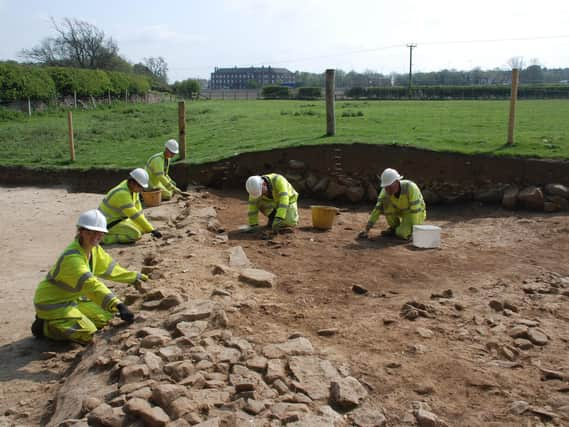Archaeological dig on the A1 in North Yorkshire uncovers Roman remains


The dig between Leeming Bar and Barton, near Scotch Corner, revealed that the Romans settled in North Yorkshire at least a decade earlier than previously thought. They produced coins for circulation and built relationships with the local tribes.
The modern A1 partly follows the route of Roman roads between York and Hadrian's Wall that were used mainly for the movements of legions based at the York garrison who were deployed to subdue the border regions.
Advertisement
Hide AdAdvertisement
Hide AdHighways England, who oversaw the archaeological work ahead of the upgrade of the A1(M), believe the finds in the vicinity of Scotch Corner are among the best discoveries of the past decade, and a book about the excavations has now been published.
Archaeologists uncovered the remains of Roman roads and even evidence of attempts to repair potholes using local limestone. They also found clues that suggested the presence of a mint where Iron Age coins were manufactured - the first of its kind north of the Humber.
Dr Jonathan Shipley, principle heritage consulatant for project partners AECOM, said: “Scotch Corner is now known as a key junction on the road network, but the remains identified show it was also the site of a much older junction.
"The remains include evidence of an Iron Age settlement where coin production, the first north of the River Humber, was potentially taking place. The extraordinary objects provided us with an insight of the interaction between the Romans and the local population.
Advertisement
Hide AdAdvertisement
Hide Ad“Other fascinating finds include evidence for the upkeep of the Roman road network, with the site revealing potholes that had been repaired. Evidence of investment in the road infrastructure during Roman times links well with the recent investment in infrastructure which resulted in the discovery of the site.”
Before major road projects begin, teams of archaeologists carefully peel back the surface of construction sites to ensure that ancient remains are preserved and recorded.
The finds are detailed in Northern Archaeological Associates' publication Contact, Concord and Conquest: Britons and Romans at Scotch Corner.
Highways England’s principal cultural heritage advisor Jim Hunter said: “At Highways England we try to have as little effect on the historic environment as we can. Where the disturbance of archaeological remains is unavoidable we are committed to recording them to as high a standard as possible so that the information they contain is available for everyone now and in the future.
Advertisement
Hide AdAdvertisement
Hide Ad“This is an exciting publication. Where important remains such as those at Scotch Corner are revealed we are proud to be able to contribute to the knowledge of the past through our funding of the archaeological work and we are delighted to have been able to add to the understanding of the Roman conquest and settlement of the north of England in this way.”
The dig has now established that Scotch Corner was a key 'hub' of the north-south route at the time. At the beginning of the first millennium AD, the region was fairly peaceful, and local tribes enjoyed good relations with the Romans. Evidence of the gifts they gave to the invaders - such as exotic objects and food - were found.
Comment Guidelines
National World encourages reader discussion on our stories. User feedback, insights and back-and-forth exchanges add a rich layer of context to reporting. Please review our Community Guidelines before commenting.